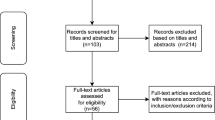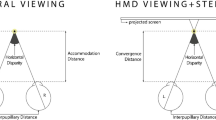Abstract
In the last 30 years, the evolution of digital data processing in terms of processing power, storage capacity, and algorithmic efficiency in the simulation of physical phenomena has allowed the emergence of the discipline known as computational fluid dynamics or CFD. More recently, virtual reality (VR) systems have proven an interesting alternative to conventional user interfaces, in particular, when exploring complex and massive datasets, such as those encountered in scientific visualization applications. Unfortunately, all too often, VR technologies have proven unsatisfactory in providing a true added value compared to standard interfaces, mostly because insufficient attention was given to the activity and needs of the intended user audience. The present work focuses on the design of a multimodal VR environment dedicated to the analysis of non-stationary flows in CFD. Specifically, we report on the identification of relevant strategies of CFD exploration coupled to adapted VR data representation and interaction techniques. Three different contributions will be highlighted. First, we show how placing the CFD expert user at the heart of the system is accomplished through a formalized analysis of work activity and through system evaluation. Second, auditory outputs providing analysis of time-varying phenomena in a spatialized virtual environment are introduced and evaluated. Finally, specific haptic feedbacks are designed and evaluated to enhance classical visual data exploration of CFD simulations.











Similar content being viewed by others
Notes
Another application, molecular docking, is presented in a separate article.
Cavity flows are classical objects of study among CFD experts. Typical applications range from minimizing noise and turbulences in fast-moving objects to the study of atmospheric distribution of urban pollution.
The software is now commercialized under the name Avizo\( ^{\circledR}\).
The probe is the representation of the haptic device in the virtual world.
The Q-factor is defined as the vorticity from which the shear component is subtracted. An isosurface of Q-factor thus highlights specific tubular microstructures in the flow.
In CFD, critical points are defined as points where the velocity vanishes.
References
Adachi Y, Kumano T, Ogino K (1995) Intermediate representation for stiff virtual objects. In: IEEE virtual reality annual international symposium ’95, Research Triangle Park, pp 203–210
André E (2000) Handbook of natural language processing. In: Chapter “The generation of multimedia presentations”, pp 305–327
Annett J (2003) Handbook of cognitive task design. In: Chapter Hierarchical Task Analysis, pp 17–35
Avila RS, Sobierajski LM (1996) A haptic interaction method for volume visualization. In: 7th conference on visualization, pp 197–204. doi:10.1109/VISUAL.1996.568108
Bryson S, Levit C (1991) The virtual windtunnel: an environment for the exploration of three-dimensional unsteady flows. In: IEEE Visualization, pp 17–24
Burdea G (1996) Force and touch feedback for VR. Wiley, Chichester
Chen K-W, Heng P-A, Sun H (2000) Direct haptic rendering of isosurface by intermediate representation. In: ACM symposium on virtual reality software and technology VRST, pp 188–194
Chinn CA, Brewer WF (1993) The role of anomalous data in knowledge acquisition: a theoretical framework and implications for science instruction. Rev Educ Res 63(1):1–49
Crawfis RA, Shen H-W, Max N (2000) Flow visualization techniques for CFD using volume rendering. In: 9th International symposium on flow visualization
Donker H, Klante P, Gorny P (2002) The design of auditory user interfaces for blind users. In: 2nd Nordic conference on human-computer interaction (NordiCHI ’02), vol 31. ACM, New York, pp 149–156
Dudas R (2002) Spectral envelope correction for real-time transposition: proposal of a “floating-formant” method. In: International computer music conference (ICMC ’02), Goteborg, pp 126–129
Ericsson KA, Simon, HA (1984/1993) Protocol analysis: Verbal reports as data (revised edition)
Fauvet N, Ammi M, Bourdot P (2007) Experiments of haptic perception techniques for computational fluid dynamics. In: Cyber world 2007, Hannover, pp 322–329
Flanagan JL (1965) Phase vocoder. J Acoust Soc Am 28(5):939–940
Gadouin E, Le Quéré P, Daube O (2001) A general methodology for investigating flow instability in complex geometries: application to natural convection in enclosures. Int J Numer Methods Fluids 37(2):175–208
Gherbi R, Bourdot B, Vezien JM, Herisson J, Fauvet N, Ferey N (2006) Le traité de la réalité virtuelle, vol 4: Les applications de la Réalité Virtuelle. In: Fuchs P, Moreau G, Papin J-P (eds) Chapter 4: Explorations de données scientifiques et expérimentations virtuelles. Presses de l’Ecoles de Mines de Paris
Ghiglione R, Landré A, Bromberg M, Molette P (1998) L’analyse automatique des contenus [Automatic content analysis]. Dunod Ed
Hoppe H (1996) Progressive Meshes ACM SIGGRAPH 96. In: Computer graphics proceedings, annual conference series, pp 99–108
Katz BFG, Warusfel O, Bourdot P, Vezien J-M (2007) CoRSAIRe—Combination of sensori-motor rendering for the immersive analysis of results. In: 2nd International workshop on interactive sonification (ISon 2007), York
Katz BFG, Rio E, Picinali L, Warusfel O (2008) The effect of spatialization in a data sonification exploration task. In: International conference of auditory display (ICAD 2008), Paris
Kramer G (ed) (1994) Auditory display: sonification, audification, and auditory interfaces. Santa Fe Institute Studies in the Sciences of Complexity, Westview Press, Santa Fe
Krner O, Schill M, Wagner C, Bender H-J, Mnner R (1999) Haptic volume rendering with an intermediate local representation. In: 1st International workshop on the haptic devices in medical applications, pp 79–84
Levoy M, Rusinkiewicz S (2000) QSplat: a multiresolution point rendering system for large meshes. In: SIGGRAPH’2000, Computer graphics proceedings, annual conference series, pp 343–352
Lorensen WE, Cline HE (1987) Marching cubes: a high resolution 3D surface construction algorithm. In: ACM SIGGRAPH 87, computer graphics proceedings, annual conference series 21(4):163–169
Lynch K (1960) The image of the city. MIT Press, Cambridge, MA
Maguire M (2001) Methods to support human-centred design. Int J Hum Comput Stud 55(4):587–634
Mark W, Randolph S, Finch M, Verth JV, Taylor RM (1996) Adding force feedback to graphics systems: issues and solutions. In: 23rd annual conference on computer graphics and interactive techniques, pp 447–452
Menelas B, Ammi M, Bourdot P (2008) A flexible method for haptic rendering of isosurface from volumetric data. In: Lecture Notes In Computer Science, vol 5024, Proceedings of the 6th international conference on haptics: perception, devices and scenarios, pp 687–693
Menelas B, Ammi M, Pastur L, Bourdot P (2009) Haptic exploration of an unsteady flow. In: Symposium on haptic interfaces for virtual environment and teleoperator systems (WorldHaptics 2009), pp 232–237
Menelas B, Ammi M, Bourdot P, Richir S (2009) Survey on haptic rendering of data sets: exploration of scalar and vector. J Virtual Real Broadcast (in press)
Nesbitt KV (2003) Designing multi-sensory displays for abstract data. PhD thesis, School of Information Technology, University of Sydney
Pastur L, Lusseyran F, Faure TM, Fraigneau Y, Pethieu R, Debesse P (2008) Quantifying the nonlinear mode competition in the flow over an open cavity at medium Reynolds number. Exp Fluids 44(4):597–608
Podvin B, Fraigneau Y, Lusseyran F, Gougat P (2006) A reconstruction method for the flow past an open cavity. J Fluids Eng. 128(3):531–540
Schnell N, Peeters G, Lemouton S, Manoury P, Rodet X (2000) Synthesizing a choir in real-time using pitch synchronous overlap add (PSOLA). In: International computer music conference, Berlin
Touraine D, Bourdot P (2001) VEserver : a manager for input and haptic multi-sensorial device. In: IEEE international workshop on robot-human interactive communication (IEEE ROMAN 2001), Bordeaux and Paris
Van Dam A, Forsberg AS, Laidlaw DH, LaViola JJ, Simpson RM (2000) Immersive virtual reality for scientific visualization: a progress report. IEEE Comput Graphics Appl 20(6):26–52
Wright M, Freed A, Momeni A (2003) Open sound control: state of the art 2003. In: International conference on new interfaces for musical expression, Montreal, pp 153–159
Ziegeler S, Moorhead RJ, Croft PJ, Lu D (2001) The MetVR case study: meteorological visualization in an immersive virtual environment. In: IEEE 12th conference on visualization (VIS’ 2001)
Acknowledgments
This work is currently supported by the ANR (French National Agency for Research) through the CoRSAIRe project of ARA-MDMSA and by the RTRA (french Thematic Network of Advanced Research) DIGITEO, through the SIMCoD project.
Author information
Authors and Affiliations
Corresponding author
Rights and permissions
About this article
Cite this article
Vézien, J.M., Ménélas, B., Nelson, J. et al. Multisensory VR exploration for computer fluid dynamics in the CoRSAIRe project. Virtual Reality 13, 257–271 (2009). https://doi.org/10.1007/s10055-009-0134-1
Received:
Accepted:
Published:
Issue Date:
DOI: https://doi.org/10.1007/s10055-009-0134-1




